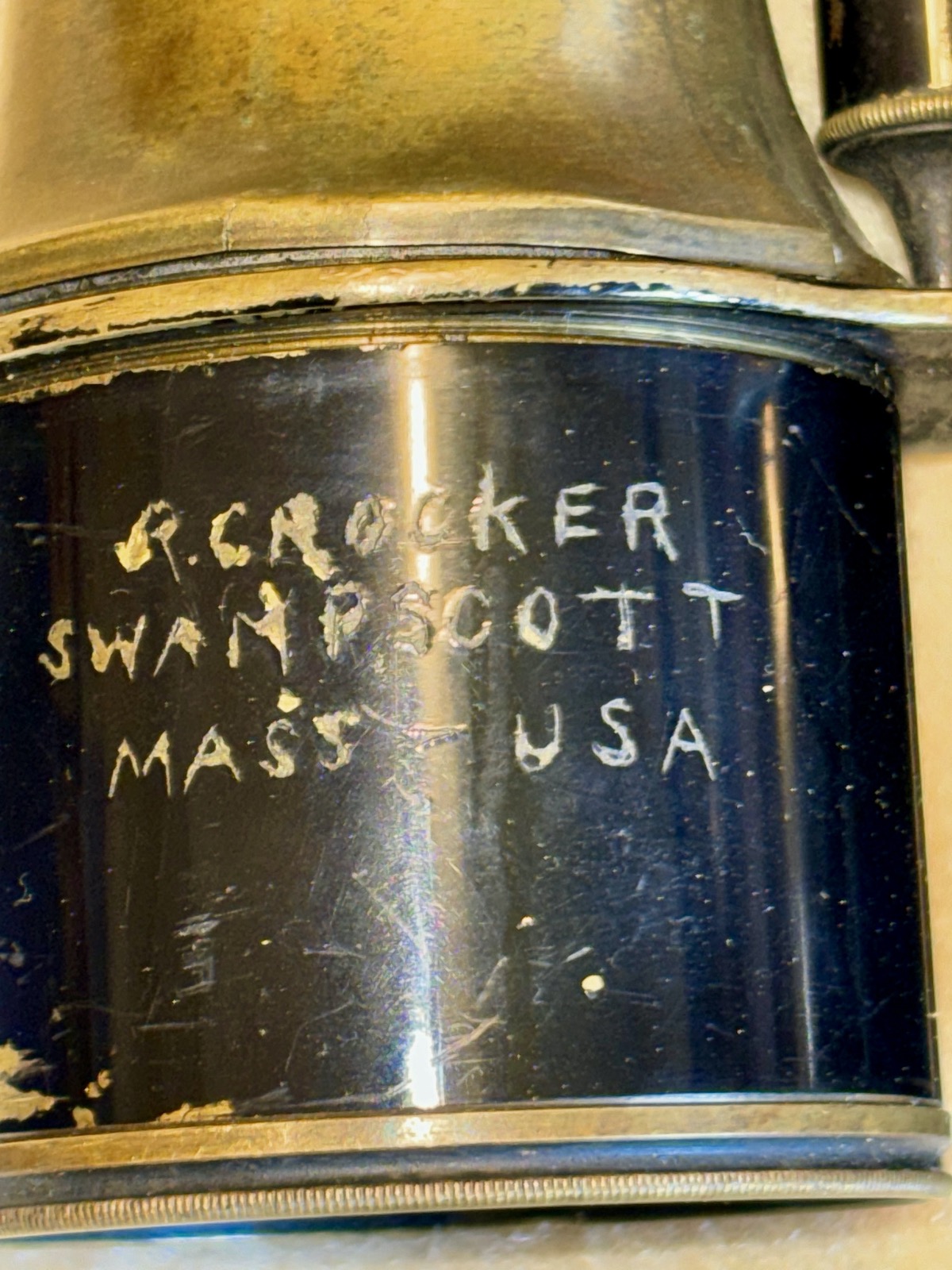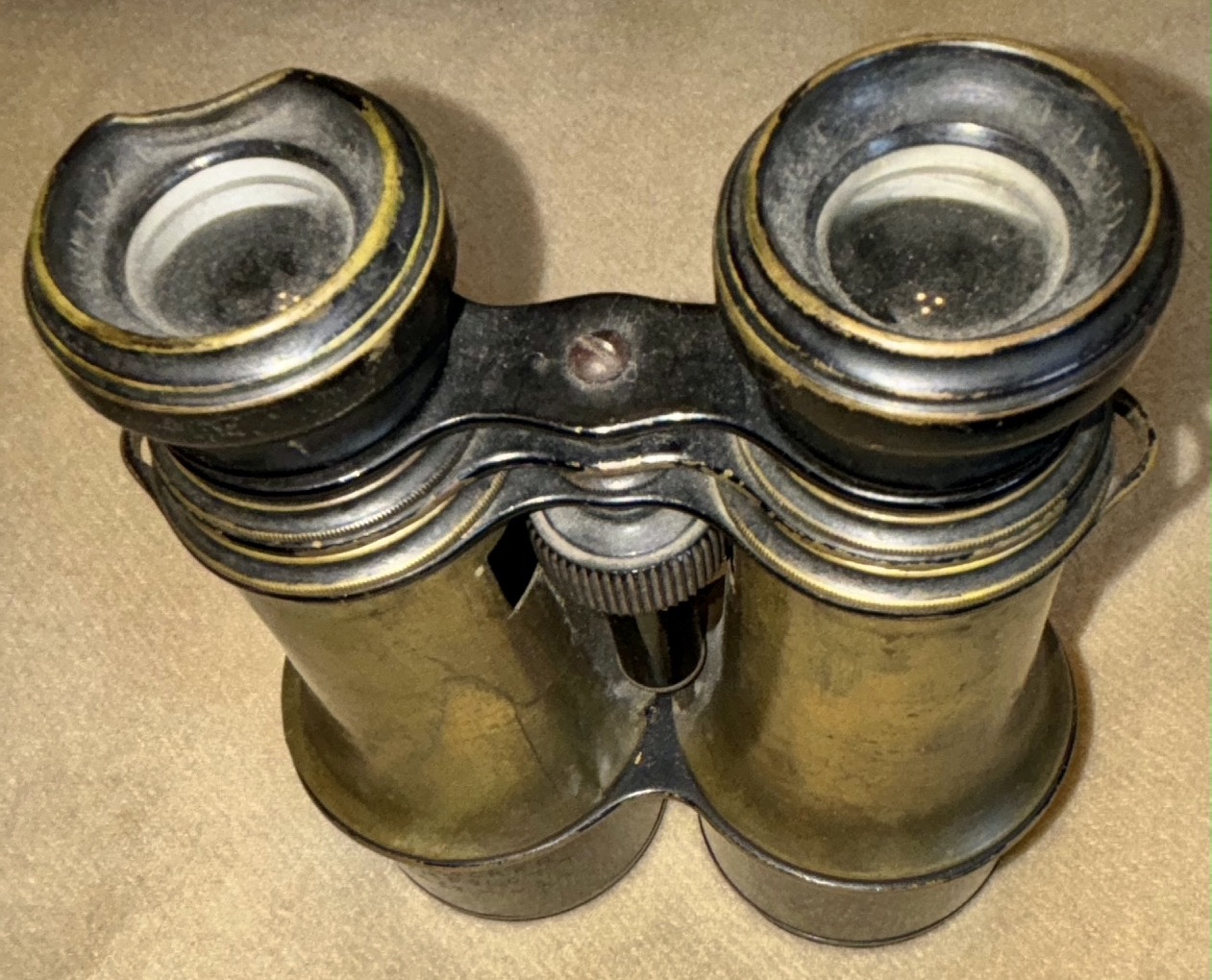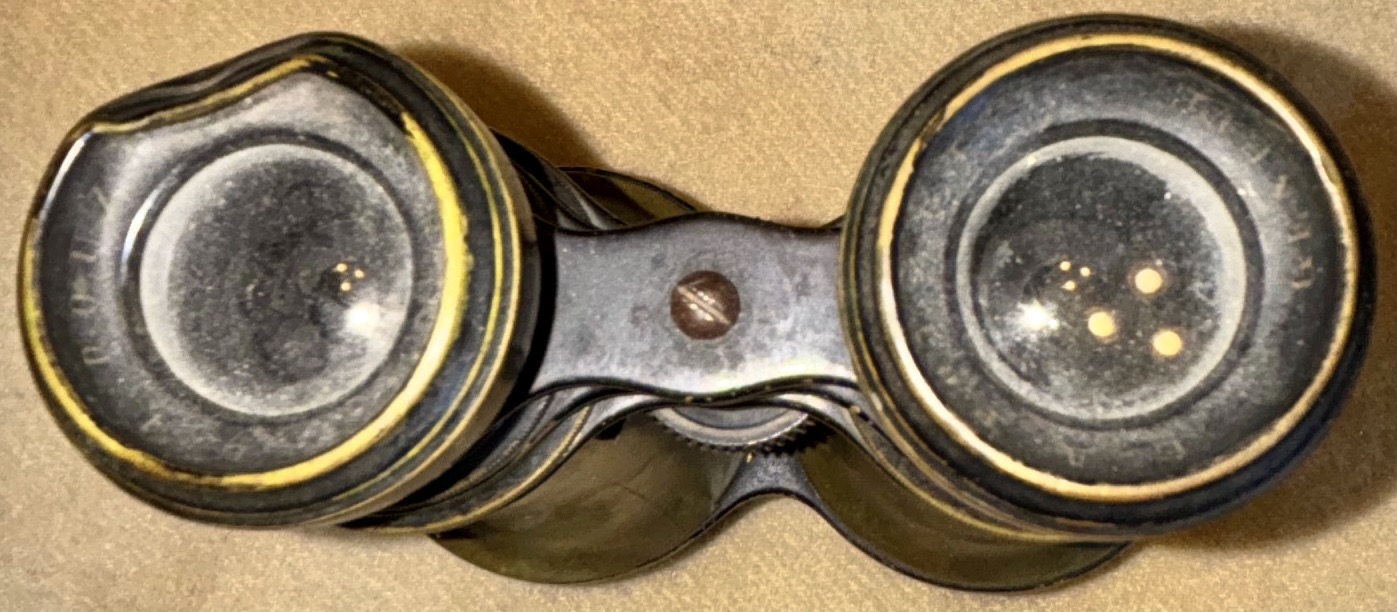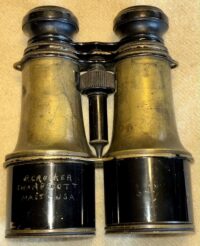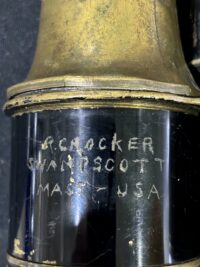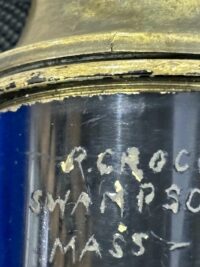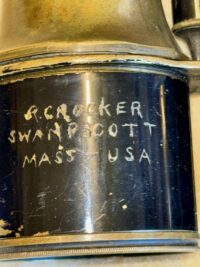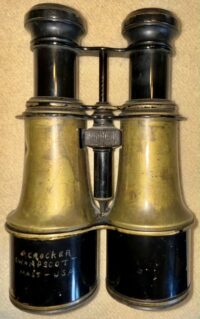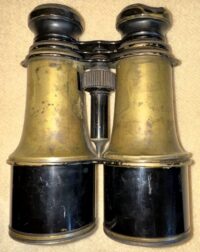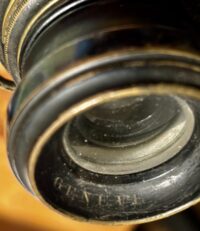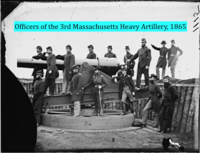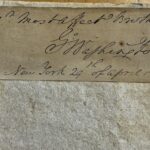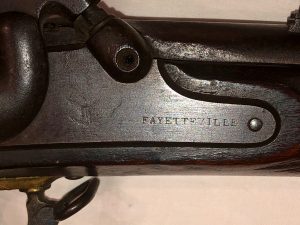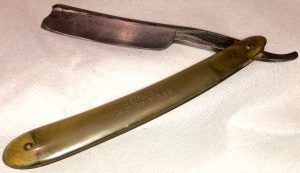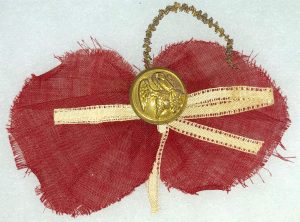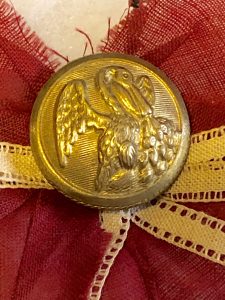Identified Pair of Civil War Field Glasses – Paul R. Crocker Co. B 3rd Massachusetts Heavy Artillery
SOLD
Identified Pair of Civil War Field Glasses – Paul R. Crocker Co. B 3rd Massachusetts Heavy Artillery – We have had numerous pairs of Civil War field glasses, with most being of French manufacture, as the French optical manufacturers were considered the premier makers of optical instruments, in the mid-19th century. This pair of Civil War period field glasses, as indicated by the inscribed maker’s marks on the interior of each of the eyepiece lens surrounds, is of French manufacture; the name inscribed is “E.A. Pouzet”; the location of manufacture is also inscribed – “Geneve”. The eyepiece lens surrounds or lens holders are constructed of enameled, brass: the bridge between the eyepieces is straight and not curved to conform to the bridge of the viewer’s nose – an indication of being from the Civil War period. The focusing stem is constructed of a thermoplastic material. On each barrel is a small, integral loop to attach a lanyard like holding device. The optics are good, although the lenses could use a cleaning. Scratched on one of the barrels of the objective lens cover is the following:
“P. CROCKER
SWAMPSCOTT
MASS – USA”
Paul R. Crocker, a young farmer from Barnstable, Massachusetts, enlisted in May, 1863, in Co. B of the 3rd Massachusetts Heavy Artillery, remaining in service, in that regiment, until mustering out in September, 1865. The 3rd Mass. Heavy artillery was initially recruited, in 1863, to garrison forts and guard the coastline of the state of Massachusetts; in January of 1864, the regiment was moved to guard Boston Harbor. In the spring of 1864, the regiment was transferred to garrison several of the “Star” forts around Washington, D.C., thereby releasing several of the regiments already positioned in the forts, for combat assignments near Petersburg. Company B and most of the other companies of the 3rd Massachusetts Heavy Artillery would remain in the Washington forts until they mustered out of service in September, 1865. We see many pairs of antique field glasses, although most are misidentified as being of war vintage, when they are, in actuality, postwar examples. This pair is definitively Civil War period; additionally, it is most uncommon to find an identified pair of war period field glasses. We surmise, that Private Crocker must have used these glasses during his time on garrison duty along the coast of Massachusetts and in a fort in the D.C. area. Several of the pieces of war period equipage we have encountered have the abbreviation “USA” enumerated – in this time period, that acronym is almost always indicative of representing “United States Army” or “U.S. Artillery”.
Paul R. Crocker
| Residence Barnstable MA; an 18 year-old Farmer.
Enlisted on 5/21/1863 as a Private.
On 6/2/1863 he mustered into “B” Co. MA 3rd Heavy Artillery He was Mustered Out on 9/18/1865 at Washington, DC |
| Name | Paul R Crocker [Kellie Attebury] | |
| Enlistment Age | 18 | |
| Birth Date | abt 1845 | |
| Enlistment Date | 21 May 1863 | |
| Enlistment Rank | Private | |
| Muster Date | 2 Jun 1863 | |
| Muster Place | Massachusetts | |
| Muster Company | B | |
| Muster Regiment | 3rd HA | |
| Muster Regiment Type | Artillery | |
| Muster Information | Enlisted | |
| Muster Out Date | 18 Sep 1865 | |
| Muster Out Place | Washington, District of Columbia | |
| Muster Out Information | Mustered Out | |
| Side of War | Union | |
| Survived War? | Yes | |
| Residence Place | Barnstable, Massachusetts | |
| Occupation | Farmer
3rd MA Heavy Artillery
|
THIRD REGIMENT
MASSACHUSETTS VOLUNTEER HEAVY ARTILLERY
THREE YEARS
| During the year 1863, eight companies of heavy artillery
were recruited for use in garrisoning the forts on the Massachusetts coast. These companies were at first designated by numbers and were mustered into the United States service as follows- the 3d Company in January, 1864, the 6th Company in May, the 7th, 8th, and 9th Companies in August, the 10th Company in September, the 11th Company in October, and the 12th Company in November. They were distributed at first for the most part at the forts and islands in Boston Harbor, the 6th Company, however, being at New Bedford, the 11th at Gloucester, and the 12th at Salem. In the spring of 1864, these eight companies were transferred to Washington, D. C., where they were assigned to do guard and garrison duty in the defenses of the capital, thereby releasing the more experienced troops, who had been performing that service, for duty at the front. Their places were taken in the forts on the Massachusetts coast by the unattached companies of infantry, whose history has been recited in an earlier portion of this work. When these first eight companies were raised it was quite distinctly stated in handbills and verbally by those engaged in the work of recruiting that they would be used only for garrison duty in Massachusetts. Hence a great deal of dissatisfaction was caused by their transfer to the defenses of Washington, and many letters and petitions of protest against that transfer were made, numbers of which are still on file in the archives of The Adjutant General’s Office. Governor Andrew was very anxious that these companies should be given a regimental status, and in order to carry that into effect four more companies, the 13th, 14th, 15th, and 16th were raised and mustered into the service, the 13th in February, 1864, the 14th and 15th in May, and the 16th in August. Finally, the proper authorization having been obtained from the War Department, by Special Order No. 1087, dated Sept. 8, 1864, the 3d Regt. Mass. Vol. Hy. Arty. was organized, the companies being arranged in their numerical order and being lettered from “A” to “M” respectively. The regiment was commanded by Col. William S. Abert, a graduate of West Point, and was divided into three battalions commanded respectively by Majors John A. P. Allen, George S. Worcester, and Lyman B. Whiton. With the exception of Company “I” the duties performed by the various units were not materially different from what they had been before they were given a regimental status. They were scattered in the forts around Washington, D. C., and there remained until their muster out. Company ” I “, nominally a part of the 3d Battalion, had an experience entirely different from that of the other companies. It was recruited largely from mechanics employed at the National Armory in Springfield, Mass., and was employed as an engineer corps It never served with the rest of the regiment, but was at once assigned to duty under Capt. F. N. Farquhar, U. S. Corps of Engineers, and was placed in charge of the pontoons of the Army of the James. After a few weeks of drill and practice the men of Company “I” became expert pontooniers. They built two pontoon bridges across the Appomattox River, connecting the Armies of the Potomac and the James, two across the James River below Chaffin’s Bluff, and in April, 1865, constructed the pontoon bridge at Farmville, which was used by the 2d and 6th Corps in the pursuit of Lee’s fleeing army. It later built the bridge at Richmond by which the Union armies crossed the James River on their way to Washington after the war was done. In addition it ran captured saw mills, built wharves and roads, and performed engineer duty in general. Company ” M ” was mustered out June 17, 1865. Ten more companies were mustered out on the 18th of September, but Company “I”, the engineer company, was held in service until the 26th of September. |
Brief History
The 3rd Regiment, Massachusetts Heavy Artillery (section) was organized for one year August, 1864, by consolidation of 3rd, 6th, 7th, 8th, 9th, 10th, 11th, 12th, 13th, 14th, 15th and 16th Unattached Companies Heavy Artillery.
It was mustered out September 18, 1865.[1]
For more information on the history of this unit, see:
- The Civil War Archive section, 3rd Regiment Heavy Artillery, (accessed 9 July 2012).
- The Wikipedia article, 3rd Regiment Massachusetts Volunteer Heavy Artillery, (accessed 9 July 2012).
Companies in this Regiment with the Counties of Origin
Men often enlisted in a company recruited in the counties where they lived though not always. After many battles, companies might be combined because so many men were killed or wounded. However if you are unsure which company your ancestor was in, try the company recruited in his county first.
3rd Regiment Heavy Artillery
Organized for one year August, 1864, by consolidation of 3rd, 6th, 7th, 8th, 9th, 10th, 11th, 12th, 13th, 14th, 15th and 16th Unattached Companies Heavy Artillery. Attached to 2nd Brigade, Hardin’s Division, 22nd Army Corps, Dept. of Washington, and engaged in garrison duty in the Defenses of Washington, north of the Potomac, to September, 1865. (For Co. “I,” 13th Unattached Company, see 13th Unattached Company.) Mustered out September 18, 1865.
Regiment lost during service 2 Enlisted men killed and 1 Officer and 38 Enlisted men by disease. Total 41.
3rd Massachusetts Heavy Artillery Regiment
| 3rd Regiment, Massachusetts Volunteer Heavy Artillery | |
| Active | Jan 1863 to 26 Sept 1865[1] |
| Country | United States |
| Allegiance | Union |
| Branch | United States Army |
| Type | Heavy artillery |
| Size | 1897 |
| Commanders | |
| Notable commanders |
Col. William S. Abert |
The 3rd Massachusetts Volunteer Heavy Artillery Regiment was a unit that served in the Union Army during the American Civil War. It was organized from already mustered unattached companies of heavy artillery raised for the defenses of the Massachusetts coast.
History
Beginning in January 1863, and continuing until early 1864, twelve companies of heavy artillery were raised in Massachusetts and mustered into service to garrison the military forts along the coast of the state. The units were designated “unattached” as they did not belong to a particular regiment.
Officers of the 3rd Massachusetts Heavy Artillery, 1865
In the spring of 1864, the 3rd Unattached Company, along with the 6th through 12th, were ordered to Washington, DC, where they were to garrison the forts protecting the capital. In June 1864, the 6th, 7th, 8th, 9th, 10th, 11th, 12th, and 14th independent companies were part of the 3rd brigade, within Joseph A. Haskin‘s division. At the same time, the 3rd and 15th companies were part of the 2nd brigade within Gustavus De Russy‘s division.
Massachusetts’ Governor Andrew called for the companies to be given regimental status, and when it was granted, several other companies since raised were sent to Washington to complete its complement, and was officially made a regiment in the fall of 1864. Except for Company I, the regiment continued with its duty of manning forts in the vicinity of the capital. A portion of the regiment was mustered out on 17 June 1865, while the remaining companies served until 18 September.
Company I
The 13th Unattached Company, which later became Company I, had been recruited in Springfield, MA and was largely composed of mechanics who were employed at the city’s National Armory. Because of their engineering skills, they were detached from the regiment and attached to the Army of the James, and were engaged in building bridges and roads. During the Siege of Petersburg, they were in charge of holding the pontoon bridge placed across the James River. They were the last men of the regiment to be mustered out, doing so on 26 September 1865.
The Unattached Companies
| Company | Unatt. # | Muster date |
| A | 3rd | 10 January 1863 |
| B | 6th | 19 May 1863 |
| C | 7th | 14 August 1863 |
| D | 8th | 14 August 1863 |
| E | 9th | 27 August 1863 |
| F | 10th | 16 September 1863 |
| G | 11th | 20 October 1863 |
| H | 12th | 20 November 1863 |
| I | 13th | 10 February 1864 |
| K | 14th | 12 May 1864 |
| L | 15th | 30 May 1864 |
| M | 16th | August 1864 |
The other unattached heavy artillery companies raised in Massachusetts, the 1st, 2nd, 4th and 5th, had become the 1st Battalion Massachusetts Volunteer Heavy Artillery in 1863.
Complement
The regiment consisted of 94 officers and 1803 enlisted men.
Organization
In April 1865, most of the regiment was part of the Army of the Potomac commanded by major general George Meade. More specifically, split between the second and third brigades in brigadier general Martin Davis Hardin‘s division:
Second Brigade (Colonel William S. Abert)
- 3rd Massachusetts Heavy Artillery, Company A – Captain Benjamin A. Ball
- 3rd Massachusetts Heavy Artillery, Company D – Lieutenant Lewis R. Whittaker
- 3rd Massachusetts Heavy Artillery, Company G – Captain Thomas Herbert
- 3rd Massachusetts Heavy Artillery, Company H – Captain George W. Pierce
- 3rd Massachusetts Heavy Artillery, Company K – Captain Edwin Thomas
- 3rd Massachusetts Heavy Artillery, Company L – Captain Joseph M. Parsons
- 3rd Massachusetts Heavy Artillery, Company M – Captain Cornelius F. Driscoll
Third Brigade (Major George S. Worcester)
- 3rd Massachusetts Heavy Artillery, Company B – Lieutenant James E. Childs
- 3rd Massachusetts Heavy Artillery, Company C – Captain Alfred W. Brigham
- 3rd Massachusetts Heavy Artillery, Company E – Captain Leonard Gordon
- 3rd Massachusetts Heavy Artillery, Company F – Captain Joseph Austin
The troops of Hardin’s division were split between the various forts around Washington DC:
- Baker
- Bayard
- Bunker Hill
- Carrell
- Davis
- De Russy
- Du Pont
- Gaines
- Greble
- Kearny
- Lincoln
- Mahan
- Mansfield
- Meigs
- Reno
- Ricketts
- Saratoga
- Simmons
- Slemmer
- Slocum
- Snyder
- Stanton
- Stevens
- Summer
- Thayer
- Totten
- Wagner
As well as a few batteries:
- Cameron
- Kemble
- Parrott
- Vermont
Losses
Two officers and 39 enlisted men died from disease or accident. None were killed in action.





